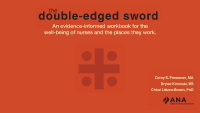Novel approaches can improve the experiences of those who deliver care.
Key Takeaways
- Quarterly employee engagement surveys with accompanying action plans can improve patient and employee satisfaction.
- Staff involvement in unit decisions through workgroups improves employee engagement.
In 2008, the Institute for Healthcare Improvement developed the Triple Aim as a framework to guide healthcare delivery in the United States. (See Triple Aim goals.) To meet these goals, healthcare organizations must function at high levels of efficiency, efficacy, and safety, which requires an engaged workforce who understands the organization’s mission and purpose.
The addition of a fourth aim emphasizes the importance of improving the experiences of those in the workforce who provide health care. In medical and behavioral healthcare settings, challenges in the work environment include increased job responsibilities, decreased staffing levels, under-resourcing, perceived stress, and lack of a nurse leader presence. These factors can trigger burnout, poor workforce engagement, and compromised patient safety.
To address these issues, our pediatric inpatient psychiatric unit developed a program of quarterly employee satisfaction surveys through which nurse managers can develop timely action plans. Our goal was to improve employee engagement, increase resource accessibility, and enhance leadership communication. Since the implementation of this program, employees see that their opinions make a difference and that the leadership team takes action in response.

Triple Aim goals
Developed by the Institute for Healthcare Improvement, the goals of the Triple Aim are:
1 improved individual patient experience.
2 enhanced population health.
3 reduce healthcare costs.
Survey says…
Nurse managers on our unit developed an employee satisfaction survey with Likert-scale responses (Strongly Agree to Strongly Disagree as well as Very Satisfied to Not Satisfied) and open-ended questions. Quantitative content in the survey includes access to resources, satisfaction with shared decision-making, satisfaction with information from management, perception of being valued, and overall job satisfaction. Open-ended questions ask for ideas on additional needed resources, suggestions for increased staff involvement, preferences for receipt of information, and requests for improvements. Administered electronically, all responses are anonymous.
This quarterly approach differs from most organizations that administer employee satisfaction surveys annually or biannually. While these less-frequent surveys provide valuable information, they don’t allow nurse leaders to keep a close watch on issues and concerns that may arise in the interim. Quarterly employee satisfaction surveys provide a consistent method for staff to share positive feedback and concerns.
Make a plan
After results from each quarterly survey are received, nurse managers develop an action plan. With transparency in mind, the managers’ action plan describes current levels of satisfaction for each item and lists every comment added to the survey. For every written concern, the nurse managers communicate what action will be taken or why it can’t be resolved at the current time.
For example, in one survey, a staff member requested that weekend shift differential be changed from Saturday/Sunday to Friday/Saturday. This issue is a hospital-wide policy, so senior administration explained that it couldn’t be changed. Even though the issue remained, the employee felt validated that the concern was acknowledged and addressed. The quarterly surveys allow staff to feel heard, and action plans show concrete evidence of nurse leaders’ transparent actions.
Workgroups in action
At our hospital, several workgroups have been established in response to survey results. They provide employees with the chance to make decisions and develop plans that directly affect their work environment. Here are three examples.
Scheduling
The scheduling workgroup analyzed several scheduling options. The group presented the chosen option to the rest of the staff for a majority vote, resulting in the decision to begin self-scheduling. Leadership implemented the decision.
Workflow
The workflow workgroup analyzed the workflows of each unit role. The group provided ideas on additional support needed for each team throughout the day. As a result, the hours of the weekend secretary were changed to better accommodate admissions and discharges, and other shifts were adjusted to meet the demands of the unit.
Supplies
Employees have been empowered to provide a monthly list of needed supplies for the unit. Two staff members organize each list and present it to the leadership team. Nurse leaders evaluate the list and order supplies as needed and as the budget allows.
Working together
Employees want to be involved in making decisions for their unit since they’re the ones most affected. There are negotiables (such as staff schedules) and non-negotiables (such as state or federal requirements), but whenever possible staff are empowered to make decisions. Based on survey feedback, our unit formed several workgroups consisting of staff members who are concerned about a particular issue. A nurse leader facilitates the workgroups, but the members are empowered to make decisions. (See Workgroups in action.)
Information sharing
Our unit philosophy is more information more often. Purposeful daily rounding and huddles create opportunities for regular interactions between nurse managers and employees. At the multiple staff huddles held by nurse managers each week, employees receive information in real-time. At the end of every week, the information is put into a newsletter emailed to the staff. The huddles reach most of the staff, and the newsletter provides the information for employees who weren’t able to attend a huddle.
Before this plan was instituted, all information was held until the scheduled monthly unit meetings, which meant the information was often outdated, and fewer than 50% of the staff attended. The new communication methods keep staff up-to-date on unit and hospital news.
Rising scores
The interventions we’ve implemented on our unit have made a positive impact in several areas, with increased Strongly Agree and Very Satisfied responses in several survey categories. (See Positive results.) Our ongoing quarterly employee satisfaction surveys and accompanying action plans provide nurse leaders with information to ensure issues are addressed quickly, and the implementation of these measures has improved both employee and patient satisfaction scores.
Positive results
Our quarterly employee satisfaction survey and resulting action plans have resulted in improved staff and patient experiences across the board. The first indication of this improvement was seen in the completion of the surveys, which rose from 37% to 57%, with increased staff feedback.
Employee satisfaction scores have improved in every area.
• Strongly Agree responses on access to tools and re- sources increased from 72% to 86%.
• Very Satisfied responses to staff involvement increased from 45% to 100%.
• Very Satisfied responses for receipt of information in- creased from 70% to 92%.
• Strongly Agree responses to being valued increased from 78% to 100%.
• Very Satisfied responses on overall job satisfaction in- creased from 70% to 92%.
Improved employee engagement has also led to im- proved patient satisfaction.
• The patient satisfaction question “How often did nurses listen carefully to you?” increased from 81% to 90%.
• The question “Using any number from 0 to 10, where 0 is the worst hospital possible and 10 is the best hospital possible, what number would you use to rate this hospital?” the rating of “10” increased from 81% to 88%.
Kenneth Longbrake is a nurse manager in psychiatry at Cook Children’s Medical Center in Fort Worth, Texas.
Selected references
Berwick DM, Nolan TW, Whittington J. The triple aim: care, health, and cost. Health Aff. 2008;27(3):759-69.
Polacek MJ, Allen DE, Damin-Moss RS, et al. Engagement as an element of safe inpatient psychiatric environments. J Am Psychiatr Nurses Assoc. 2015;21(3):181-90.
Sikka R, Morath JM, Leape L. The Quadruple Aim: Care, health, cost and meaning in work. BMJ Qual Saf. 2015;24(10):608-10.
Van Bogaert P, Wouters K, Willems R, Mondelaers M, Clarke S. Work engagement supports nurse workforce stability and quality of care: Nursing team-level analysis in psychiatric hospitals. J Psychiatr Ment Health Nurs. 2013;20(8):679-86.
focusing Quadruple aim health care American nurse today


















1 Comment.
I appreciated the author’s focus on the employee experience, complementing the Institute for Healthcare Improvement’s 2008 goals of: improved individual patient experience, enhanced population health, and reduced healthcare costs (Longbrake, 2017). As the author indicated, employees want to feel valued and know their needs and concerns are heard by management (Longbrake, 2017).
Regarding the utilization of a quarterly employee satisfaction survey, the premise appears valid; gathering data and feedback on unit-related issues, so matters can be handled in a timely fashion (Longbrake, 2017). While integration of the quarterly survey has seemed to yield positive results on this unit, other facilities may struggle with staff buy-in, when introducing this more-frequent employee engagement tool. Employees will want assurances their commitment will yield a meaningful return, worthy of continued involvement (French-Bravo & Crow, 2015).
The challenges facing healthcare staff today are many and any innovation addressing the healthcare delivery goals, as set forth by the Institute for Healthcare Improvement and includes employee satisfaction, seems viable, to this healthcare professional. It also seems likely for innovations, such as the one highlighted in the article, to succeed, will require strong transformational nurse leaders, committed to motivating and empowering staff to immerse themselves in the complexities of the nursing profession, as we provide safe, quality, cost-effective care in our communities.
References
French-Bravo, & Crow. (2015). Shared governance: The role of buy-in in bringing about change. Online Journal of Issues in Nursing, 20(2), 8. doi:10.3912/OJIN.Vol20No2PPT02
Longbrake. (2017). Focusing on the quadruple aim of healthcare. American Nurse Today, 12(7), 44-46.